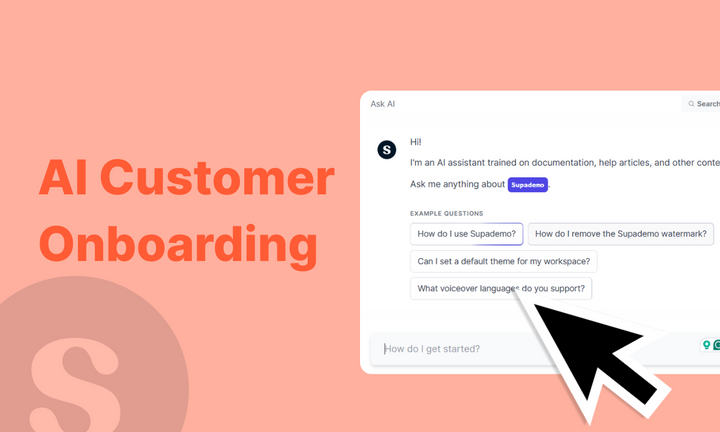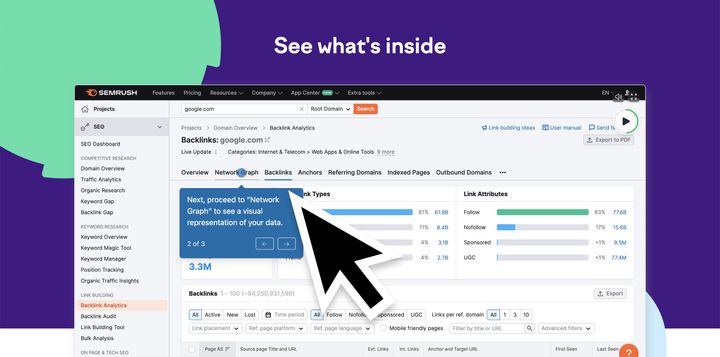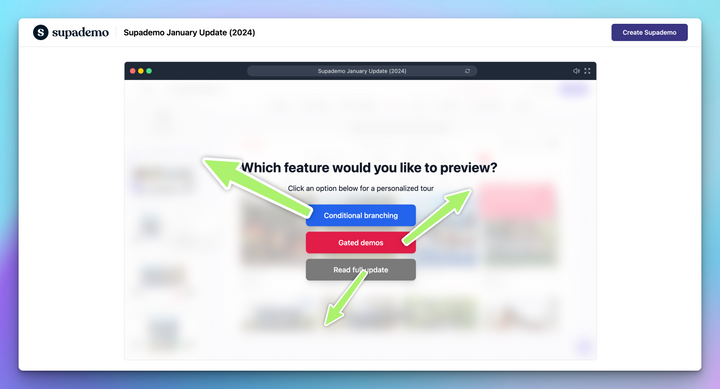Onboarding plays a major role in whether a user becomes a long-term customer or drops off after their first session. In fact, 63% of customers say a company’s onboarding experience influences their purchase decision.
The problem? Most onboarding flows are static, one-size-fits-all, and rely heavily on manual effort. They don’t adapt to different user needs, roles, or behaviors. That leads to missed activation moments, higher support load, and slower product adoption.
This is where AI can make a difference.
In this blog, we’ll break down how AI can enhance each stage of the onboarding journey and share 9 practical ways to use it to enhance customer experiences.
What is AI customer onboarding?
AI customer onboarding uses artificial intelligence to personalize the onboarding experience based on real user behavior. It adapts onboarding flows, surfaces relevant content, and addresses friction in real time, so every customer gets a faster, more relevant experience without manual effort.
The goal of AI onboarding is to:
- Reduce the friction that prevents customers from exploring your product or reaching value
- Enable self-service, so users don’t have to rely on support at every step
- Hyper-personalize the experience based on user roles, industries, or behaviors
- Cut down manual work, so your team can focus on building customer relationships instead of managing repetitive onboarding tasks
What stages of customer onboarding can AI enhance?
AI can improve every phase of onboarding, from the first click to long-term engagement. Here’s how it adds value at each key stage:
| Stage | How AI Enhances the Experience |
|---|---|
| Sign-up Process | AI auto-fills fields, detects friction early, and personalizes next steps based on inputs like role or company size—ensuring users see relevant content immediately. |
| Core Onboarding Experience | AI adapts flows in real time—surfacing tooltips, tours, or walkthroughs based on behavior—keeping users on track without overwhelming them. |
| Post-Onboarding Engagement | AI tracks user activity to trigger personalized follow-ups—recommending features, sending nudges, or offering support when users stall, keeping them active and progressing. |
9 Practical ways to use AI in customer onboarding
You’ve seen where AI fits across the onboarding journey. But how do you actually put it into action?
Here are 9 practical ways to use AI in your onboarding strategy, whether you're trying to scale support, personalize flows, or drive product adoption faster.
1. Segment users
Effective onboarding starts with knowing your users — and AI makes segmentation effortless.
Instead of spending weeks manually analyzing user data, AI instantly segments users based on signup information and early product behavior. Within minutes of registration, AI can automatically categorize users into precise segments like "marketing directors at mid-market SaaS companies" or "solo founders building their first product."
This real-time segmentation transforms your onboarding from generic to hyper-relevant. Marketing directors immediately see campaign automation features, while technical founders are guided toward API documentation and developer tools. The result? Users reach their "aha moment" faster because they're experiencing exactly what matters to their role and goals.
2. Create personalized onboarding guides
Before AI, creating personalized onboarding was tedious. You had to record separate tours for each customer, write custom scripts, and redo everything whenever the UI changed.
Today, AI tools like Supademo simplify this. All you have to do is just record your product flow once, and it gets converted into an interactive, editable walkthrough you can tailor for different personas. You can also personalize names, use cases, and data at scale using AI.
Here's an example of an interactive tour personalized using name and company :
Here's another example of an interactive tour personalized with specific use cases:
3. Localize content for global users
Turn language barriers into competitive advantages with AI-powered localization that makes every user feel seen.
Global users abandon products 3x more often when onboarding feels foreign or confusing. AI eliminates this friction by instantly adapting your entire onboarding experience — tooltips, walkthroughs, welcome sequences, and even voiceovers — to each user's native language and cultural context.
But true localization goes beyond translation. AI understands regional preferences, adjusting everything from color schemes that resonate culturally to communication styles that feel natural.
Supademo makes this sophisticated localization accessible to any team. Create your onboarding flow once, then let AI adapt it for dozens of markets — no development resources required, no content duplication headaches.
Here’s an example of Wise product walkthrough available in 7 languages created using Supademo AI Translation and voiceovers.
4. Auto-sync data with CRM
During onboarding, users share data such as their name, role, company size, and use case. AI ensures this information is automatically synced to your CRM, keeping records accurate and actionable without manual work.
For example, Supademo can gather form data from interactive walkthroughs, auto-detect field names, and map them to your CRM. Whether the field says “Company” or “Organization,” the data flows cleanly into tools like HubSpot or Salesforce.
5. Improve self-service with AI chatbots
With AI chatbots, you can offer round-the-clock support, even when your team is offline. Customers can ask questions directly in your app and get immediate, helpful responses.
For example, at Supademo, we’ve implemented in-app AI assistance that answers any questions related to how to use the platform. If you ask, “How do I use Supademo?” it will respond with a context-aware answer. What’s more, it will guide you to an interactive walkthrough covering all major Supademo use cases.

6. Identifying account expansion opportunities
AI can help you see when a customer is ready to upgrade, without waiting for them to reach out. It looks at things like usage patterns, feature adoption, or when they hit limits, and flags accounts that show buying signals.
You can use that data to trigger an upsell prompt, unlock a premium feature walkthrough, or loop in your sales or success team. It’s a simple way to act on real product usage instead of guessing who’s ready to grow.
7. Optimizing onboarding flows
AI helps you understand how users move through your onboarding—what they click, skip, or abandon.
With Supademo analytics, these insights become even more actionable. You can track which steps users engage with most, how long they spend on each tutorial, and where they drop off. This makes it easy to spot friction and improve the flow based on real behavior.
Need to fix something? Updating a Supademo is quick; you can record a new walkthrough or edit an existing one without waiting on engineering. It’s a faster, more flexible way to keep your onboarding relevant and conversion-ready.
8. Automate support content creation
AI can analyze support tickets, user behavior, and your existing help center to identify trends, bottlenecks, and content gaps. For example, if users frequently ask how to use “Team Workspaces,” it’s a clear signal that your documentation needs more clarity on that feature.
Once those gaps are identified, Supademo makes it easy to turn complex workflows into interactive guides. Instead of writing another step-by-step article, you can show users what to do, making your support content more engaging, scalable, and easier to maintain.
The result? 80+ self-serve guides created and 3 hours of redundant support work eliminated weekly.
9. Trigger automated follow-up and engagement
Before AI, re-engaging inactive or stalled users required manual tagging, segmentation, and guesswork.
Today, AI does the heavy lifting. It monitors user behavior, such as skipping steps, abandoning onboarding flows, or going inactive, and triggers personalized follow-ups in real-time.
Here's an example of Clockwise's follow-up email when users are inactive:

3 AI onboarding solutions you need for customer onboarding
Ready to implement AI in your onboarding strategy? Here are three powerful tools that can transform how you welcome and guide new customers through your product.
1. Supademo
Supademo is an AI-powered interactive demo purpose-built for sales, marketing, customer success, and product teams to create engaging product demos.
Over 90,000 professionals at fast-growing companies like Pokemon, Bullhorn, Beehiiv, and Porter Metrics use Supademo to drive product adoption and create smooth customer onboarding experiences.
How does Supademo help in AI-powered customer onboarding?
- Create instant interactive walkthroughs: Record your product workflow once via Chrome extension or Desktop app, and Supademo automatically converts it into step-by-step interactive walkthroughs that preserve all hover states and animations for pixel-perfect replicas.
- AI-powered personalization at scale: Use dynamic variables to automatically insert user names, company information, and role-specific content into demos.

- Localize onboarding content: Generate and add AI text annotations, translations, and voiceovers in 15+ languages to create personalized experiences without manual effort.

- Multi-demo onboarding kits: Create comprehensive onboarding showcases by grouping related demos into single shareable collections, allowing users to navigate different features at their own pace while tracking progress through each section.
- Analyze onboarding engagement: Built-in analytics track exactly where users engage most, how long they spend on each step, and where they drop off, enabling data-driven optimization of onboarding flows based on real user behavior.
- Drive product adoption across touchpoints: Embed interactive demos in websites, emails, support docs, knowledge bases, and in-app modals to provide contextual onboarding guidance wherever users need it most.
2. Fin AI by Intercom
Fin is the highest-performing AI Agent in customer service, delivering higher-quality answers and resolving more complex queries than any other AI Agent. It's specifically designed to handle customer inquiries during the critical onboarding phase when users need immediate support.

How does Fin AI help in customer onboarding?
- Comprehensive knowledge integration: Automatically learns from help center articles, PDFs, internal documentation, and external systems to provide complete answers to onboarding questions without requiring new content creation.
- Smart issue categorization: AI category detection automatically identifies and routes onboarding-related conversations (setup issues, feature questions, frustration signals) according to your predefined workflows and escalation rules.
- Seamless human handoffs: When complex onboarding issues arise, escalates to human agents with full conversation context and user data, ensuring continuity without forcing users to repeat their problems.
3. HeyGen
HeyGen offers AI-generated avatars, voice cloning, and a multilingual video translator, allowing customer teams to create personalized onboarding videos at scale.

How does HeyGen help in customer onboarding?
- Interactive Avatar Support: Choose from 120+ AI Avatars & 300+ voices to engage viewers in real time. The AI avatars can answer questions, guide users, or deliver dynamic content by connecting to scripts or knowledge bases.
- Video translation & lip-syncing: Translate videos into 25+ languages while ensuring natural lip-syncing for localized outreach.
- Pre-built video templates: Access 400+ templates designed for sales, marketing, and training, making video creation fast and effortless.
Ready to transform your customer onboarding with AI?
Today, AI has proved to be game-changing for companies looking to provide a seamless customer experience. The 9 methods we've covered show exactly how AI eliminates the guesswork from onboarding by personalizing flows, providing instant support, and adapting to real user behavior instead of assumptions.
Most companies still rely on static, one-size-fits-all onboarding that frustrates users and wastes resources. AI changes that by making every interaction smarter and more relevant.
If you're looking to create a low-effort but high-impact onboarding experience for your customers, Supademo can help. Create interactive, personalized demos in minutes instead of weeks.
FAQs
How does AI personalize the onboarding experience?
AI analyzes user data from forms and in-app behavior to automatically tailor onboarding flows. It ensures each user sees the most relevant guides, checklists, or product features based on their role and goals.
Can AI reduce onboarding-related support requests?
Yes. AI chatbots can answer repetitive questions, surface interactive tutorials, and guide users through key actions, reducing the need to contact your support team for common issues.
How does AI help identify onboarding friction?
AI tracks drop-off points, skipped steps, and delayed clicks to highlight where users get stuck, so you can fix specific steps that block activation.
How does AI support multilingual onboarding?
AI can automatically translate onboarding flows, tooltips, and product guides into each user’s preferred language, eliminating the need to build separate versions manually.
What kind of onboarding content can AI generate?
AI can generate step-by-step guides, recommend product tours, and turn support ticket trends into helpful content. For example, with AI-powered demo platforms like Supademo, you can create interactive onboarding walkthroughs tailored to each user segment, without manual re-recording.




